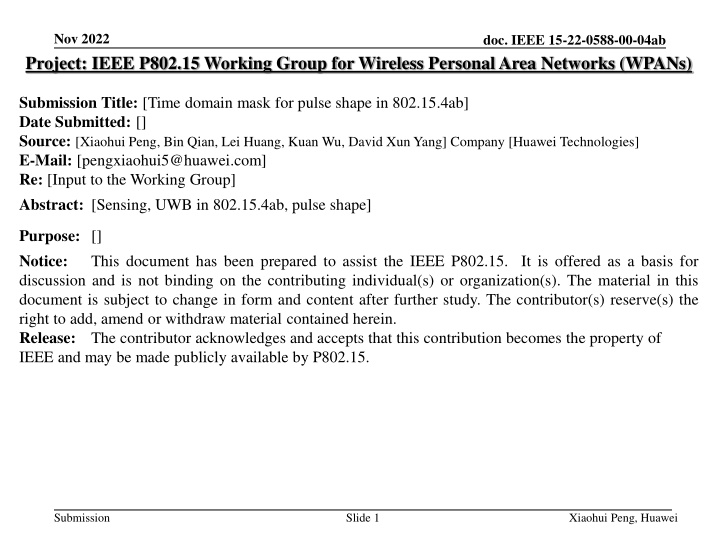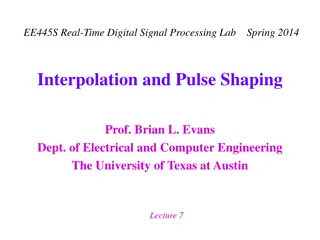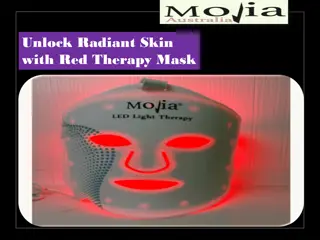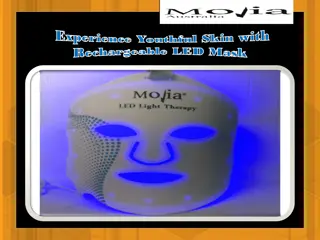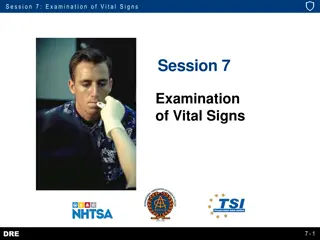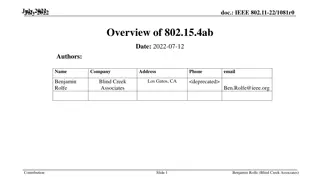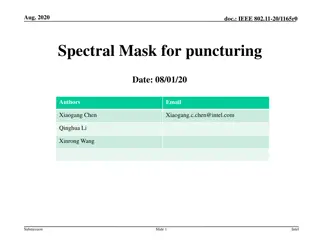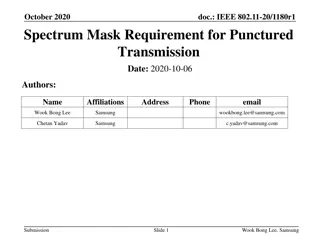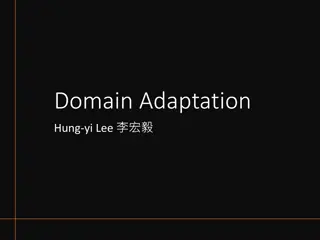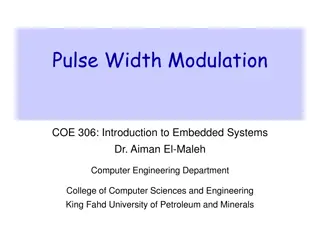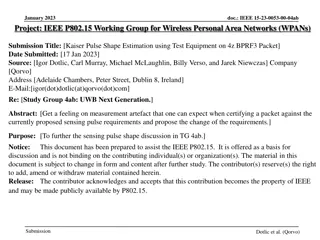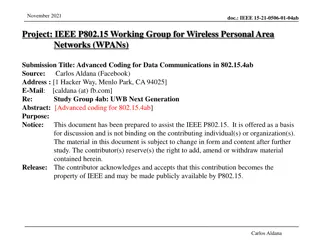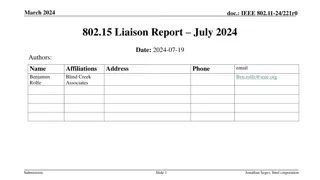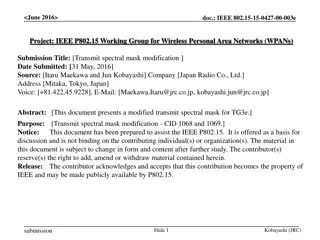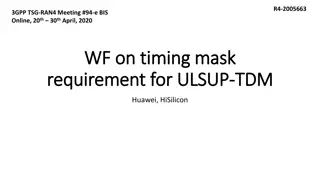Time Domain Mask for Pulse Shape in 802.15.4ab
Submission to IEEE P802.15 Working Group proposing safeguards to prevent disruption in high throughput data use cases along with interference mitigation techniques, coexistence improvements, enhanced ranging capabilities, and enhancements for accuracy, reliability, and interoperability in wireless personal area networks.
Download Presentation

Please find below an Image/Link to download the presentation.
The content on the website is provided AS IS for your information and personal use only. It may not be sold, licensed, or shared on other websites without obtaining consent from the author.If you encounter any issues during the download, it is possible that the publisher has removed the file from their server.
You are allowed to download the files provided on this website for personal or commercial use, subject to the condition that they are used lawfully. All files are the property of their respective owners.
The content on the website is provided AS IS for your information and personal use only. It may not be sold, licensed, or shared on other websites without obtaining consent from the author.
E N D
Presentation Transcript
Nov 2022 doc. IEEE 15-22-0588-00-04ab Project: IEEE P802.15 Working Group for Wireless Personal Area Networks (WPANs) Submission Title: [Time domain mask for pulse shape in 802.15.4ab] Date Submitted: [] Source:[Xiaohui Peng, Bin Qian, Lei Huang, Kuan Wu, David Xun Yang] Company [Huawei Technologies] E-Mail: [pengxiaohui5@huawei.com] Re: [Input to the Working Group] Abstract: [Sensing, UWB in 802.15.4ab, pulse shape] Purpose: [] Notice: discussion and is not binding on the contributing individual(s) or organization(s). The material in this document is subject to change in form and content after further study. The contributor(s) reserve(s) the right to add, amend or withdraw material contained herein. Release: The contributor acknowledges and accepts that this contribution becomes the property of IEEE and may be made publicly available by P802.15. This document has been prepared to assist the IEEE P802.15. It is offered as a basis for Submission Slide 1 Xiaohui Peng, Huawei
Nov 2022 doc. IEEE 15-22-0588-00-04ab PAR Objective Proposed Solution (how addressed) Safeguards so that the high throughput data use cases will not cause significant disruption to low duty-cycle ranging use cases Interference mitigation techniques to support higher density and higher traffic use cases Other coexistence improvement Backward compatibility with enhanced ranging capable devices (ERDEVs) Improved link budget and/or reduced air-time Unified pulse shape for ranging and sensing Additional channels and operating frequencies Improvements to accuracy / precision / reliability and interoperability for high-integrity ranging Reduced complexity and power consumption Hybrid operation with narrowband signaling to assist UWB Enhanced native discovery and connection setup mechanisms Sensing capabilities to support presence detection and environment mapping Low-power low-latency streaming Pulse shape design for sensing Higher data-rate streaming allowing at least 50 Mbit/s of throughput Support for peer-to-peer, peer-to-multi-peer, and station-to- infrastructure protocols Infrastructure synchronization mechanisms Submission Slide 2 Xiaohui Peng, Huawei
Nov 2022 doc. IEEE 15-22-0588-00-04ab Related Submissions 15-19-0443-01-004z text to address comment id r1-0820 (Michael McLaughin) 15-20-0084-00-004z pulse shaping considerations (Jochen Hammerschmidt) 15-20-0086-00-004z proposed pulse shape text changes for HRP UWB PHY (Michael McLaughin) 15-20-0089-01-004z pulse shape text changes for HRP UWB PHY (Michael McLaughin) 15-22-0040-04-04ab waveform design for UWB sensing (Xiaohui Peng) 15-22-0418-00-04ab sensing pulse shape consideration in 802.15.4ab (Xiaohui Peng) 15-22-0175-00-04ab sensing device (Dag T. Wisland ) 15-22-0061-00-04ab sensing continued (Frank Leong) 15-22-0305-00-04ab a summary of proposals and interests (Billy Verso) 15-22-0418-00-04ab-sensing-pulse-shape-consideration-in-802-15-4ab continued (Xiaohui Peng) Submission Slide 3 Xiaohui Peng, Huawei
Nov 2022 doc. IEEE 15-22-0588-00-04ab Recap For sensing application, a pulse shape should be designed to minimize both precursors and postcursors The pulse shape should be designed to support both ranging and sensing applications The specific criteria for sensing pulse shape include range resolution, PSLR (Peak to sidelobe ratio) of the cross-correlation function, spectrum efficiency (or root mean square bandwidth) Pulse shape does not change in the middle of packet. Sensing pulse shape is used for entire packet in sensing applications. A more restrictive time-domain mask should be specified for the sensing pulse shape than ranging Submission Slide 4 Xiaohui Peng, Huawei
Nov 2022 doc. IEEE 15-22-0588-00-04ab Sensing pulse shape (Recap) Time bounded Gaussian pulse a Gaussian pulse is shaped as a Gaussian function with no precursor and postcursor. It can be expressed as: ?(?) = ?? ?2 2?2, ? ?/2 ? > ?/2 0, ???? 2.355? where A is the amplitude and ? is related to the full- width at half-maximum FWHM 2.355?. (FWHM), i.e., Time bounded Kaiser pulse a Kaiser pulse is shaped as a Kaiser-Bessel window also with no precursor and postcursor. It can be expressed as: 2 2? ? ?0?? 1 1 ? 0, ?(?) = , ? ?/2 ?0?? ? > ?/2 where I0 is the zeroth-order modified Bessel function of the first kind. L is the window duration, ? = ?? is a parameter determining the shape of the pulse. Submission Slide 5 Xiaohui Peng, Huawei
Nov 2022 doc. IEEE 15-22-0588-00-04ab Motivation The pulse shape should be designed to support both ranging and sensing applications, thus the pulse shape defined in 4ab shall be able to meet the mask defined in 4z. [Consensus]: Pulse shape does not change in the middle of packet. Sensing pulse shape is used for entire packet in sensing applications. For sensing application, a pulse shape should be defined to avoid both precursors and postcursors. Thus, an more restrictive time domain mask should be defined. An additional time domain mask should be defined on top of the time domain mask defined in 4z. Submission Slide 6 Xiaohui Peng, Huawei
Nov 2022 doc. IEEE 15-22-0588-00-04ab Time domain mask for 4ab pulse shape Proposed time domain mask for 4ab Time domain mask defined in 4z Gaussian pulse shape with ? = 8.8? 10 Kaiser pulse shape with ? = 10 A: (-1.25,0.015) An additional more restrictive time domain mask is proposed on top of 4z. The dashed line with blue color is the additional mask, the line with red color is the mask defined in 4z, and the mixed color is the overlaps of two masks. As specified in ranging, the recommendation of point A will allow detection of weak first path up to 35dB more attenuated than a subsequent echo path. [7] Submission Slide 7 Xiaohui Peng, Huawei
Nov 2022 doc. IEEE 15-22-0588-00-04ab Time domain mask for 4ab pulse shape Proposed time domain mask for 4ab Gaussian pulse shape with ? = 8.8? 10 Kaiser pulse shape with ? = 10 Tb (1,0.3) (Tw-1.25,0.3) Tw=(1+2 )Tc Td= 0.6Tp y= 0.015 y= 0.015 Tc=2.5Tp (-1.25,0.015) y= -0.015 How to define the additional time domain mask The lower bound of the additional time domain mask is a line defined by y = -0.015. Tc is defined as the time duration between two points in the pulse shapes (Gaussian and Kaiser) with y=0.015. Tw is the width to constrain the mainlobe duration defined as Tw =(1+2 )Tc, where (e.g., = 0.1) is a parameter used to define the margins. Tb is the time duration between two break points, it should be designed larger than Td Submission Slide 8 Xiaohui Peng, Huawei
Nov 2022 doc. IEEE 15-22-0588-00-04ab Summary To improve sensing performance, a pulse shape should be defined to avoid both precursors and postcursors. An more restrictive time domain mask is defined on top of the time domain mask defined in 4z It can be used to avoid both precursors and postcursors to ensure sensing performance. It is compatible with legacy device, which means that if a specific pulse is comply with the new time mask proposed here, it will also comply with the time domain mask defined in 4z. Submission Slide 9 Xiaohui Peng, Huawei
Nov 2022 doc. IEEE 15-22-0588-00-04ab References 1. Amendment1: Enhanced ultra wideband (UWB) physical layers (PHYs) and associated ranging techniques IEEE standard for low-rate wireless networks UWB spectral mask and FFC part 15 limits 15-19-0443-01-004z text to address comment id r1-0820 (Michael McLaughin) 15-20-0084-00-004z pulse shaping considerations (Jochen Hammerschmidt) 15-20-0086-00-004z proposed pulse shape text changes for HRP UWB PHY (Michael McLaughin) 15-20-0089-01-004z pulse shape text changes for HRP UWB PHY (Michael McLaughin) 15-22-0040-04-04ab waveform design for UWB sensing (Xiaohui Peng) 15-22-0175-00-04ab sensing device (Dag T. Wisland ) 10. 15-22-0061-00-04ab sensing continued (Frank Leong) 11. 15-22-0305-00-04ab a summary of proposals and interests (Billy Verso) 12. 15-22-0418-00-04ab-sensing-pulse-shape-consideration-in-802-15-4ab continued (Xiaohui Peng) 2. 3. 4. 5. 6. 7. 8. 9. Submission Slide 10 Xiaohui Peng, Huawei
